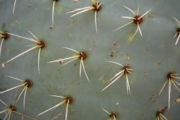Translate This Page
Rare Cactus How to eat Prickly Pear Cactus
Prickly pear cactus has been a staple of the Mexican and Central American diet for thousands of years. How to eat Prickly Pear Cactus Warnings: Some species of prickly pear cactus don't have spines, but all have glochids
Steps for preparing the pads to eat
Pads or Nopales
Find pads that are bright green and firm.
Small, young pads harvested in early spring are thought to be the most succulent, delicate in flavor, and have the fewest spines. The thicker a pad, the older it is. Older pads tend to be stringy and their sap will be thicker, which some people find unpleasant. Leave those for other species who use them as survival food during lean foraging seasons. The tender pads are sometimes sold as "baby nopales".
If you're harvesting them yourself, wear extremely heavy gloves or use tongs. Snap the pads off the plant or cut at the stem. Cutting at the stem reduces stress on the pad, and allows the cactus to recover more quickly than snapping or tearing the pad away. This helps keep your cactus plant healthy for future harvests.
2. Remove the spines from the pad by using a vegetable peeler or a paring knife. Don't take off the gloves until the pads are completely rinsed and the peeled remnants are cleared. The pads not only have large spines, but there are also tiny, invisible and far more irritating spines called glochids that are extremely difficult to remove from the skin. The spines and glochids can also be removed from the prickly pear pads by burning them off with a small torch or by placing the pad on a gas burner and turning it with tongs. See Warnings.
3. Run the pad under cool water. Peel or cut off any discolorations or bruises.
4. Slice or cut the pads (wipe the knife blade after each slice, as there can be small spines sticking to it), or leave them whole, depending on what you will be using the nopales for. .
How
to Eat Prickly Pear Cactus Prickly pear cactus
has been a staple of the Mexican and Central American diet for thousands of
years. In parts of the U.S. it has been gaining
popularity as an exotic, gourmet and healthy addition
to one's diet. The prickly pear plant
has three different edible sections: the pad of the cactus (nopal),
which can be treated like a vegetable,
the petals of the flowers, which can be added to salads, and the pear (tuna),
which can be treated like a fruit. They grow wild throughout the American
southwest, down to South America and up to Canada.
The ones you may find at a local store or farmers
market will surely
originate from a commercial nopal farm.
Ingredients
Nopales (prickly pear pads)
Prickly pear (the fruit of the cactus)
Pepper, salt, other spices
Warnings
Some species of prickly pear cactus don't have spines, but all have glochids.
Unless you wear extremely heavy gloves, it's best to handle the pads with tongs or some other "remote" device.
If harvesting your own plants, always wear hand protection.
Beware pear cactus can poke thorns through you and hurt really bad.
 Spines
Spines
Be very careful when removing the spines from the plant, or buy pads or pears that are already de-spined.